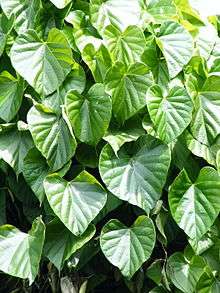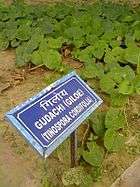Tinospora cordifolia
| Tinospora cordifolia | |
|---|---|
 | |
| Scientific classification | |
| Kingdom: | Plantae |
| Clade: | Angiosperms |
| Clade: | Eudicots |
| Order: | Ranunculales |
| Family: | Menispermaceae |
| Genus: | Tinospora |
| Species: | T. cordifolia |
| Binomial name | |
| Tinospora cordifolia (Thunb.) Miers | |
Tinospora cordifolia, which is known by the common names heart-leaved moonseed,[1] guduchi and giloy, is an herbaceous vine of the family Menispermaceae indigenous to the tropical areas of India, Myanmar and Sri Lanka.
Vernacular names
There are many common names for this species in different languages. Sanskrit: guduchi, amrta, cinnodbhava (छिन्नोद्भवा), etc. Punjabi: گلو (Gllow), Telugu: తిప్ప తీగ (Tippa-teega), Tamil: சீந்தில் கொடி (Shindilakodi), Malayalam: ചിറ്റമൃത് (Amruthu, Chittamruthu), Kannada: ಅಮೃತ ಬಳ್ಳಿ (Amrutha balli),[14] Khmer: បណ្តូលពេជ្រ (bândaul pich), Sinhala: රසකිද Rasakinda, Thai: บอระเพ็ด (boraphét), Lao: ເຄືອເຂົາຫໍPali: galocī, Hindi:geloy (गिलोय), guruc (गुरुच), gurcha, Gujarati: galac, garo, Bengali: Gulancha, Marathi: Guduchi (गुडूची), Gulvel (गुळवेल), Odia: Guluchi, Myanmar: ဆင်တုံးမနွယ် Nepali: Gurjo (गुर्जो). Konkani: amritvel Manipuri name – ningthou khongli Mizo: theisawntlung Urdu: gurch, guluncha
Sanskrit Synonyms: There are different Sanskrit Synonyms for Tinospora, mainly denoting its properties or characteristics. For example- Amrita (अमृता) - it is one of the most used synonym. It means nectar. Many formulations use this name of Guduchi. Example: Amritottara Kashaya, Amritarishta, Guduchi (गुडूची)– It protects and guards body from diseases. Chakrangi, (चक्रांगी) Chakralakshana (चक्रलक्षणा)– wheel-like appearance in transverse section of stem. Chandrahasa (चंद्रहासा)– It refers to the moon like appearance of transversely cut stem. Chinnaruha(छिन्नरुहा), Chinnodbhava (छिन्नोद्भवा) – Regular growth of plant even if it is cut-off several times. Regular emergence of plant even if it is cut-off several times. Jwarari(ज्वरारि), Jwaranashini ज्वरनाशिनी)– Useful against fever Ayattha, Amravalli, Kundali, Guduchika, Jivantika, Tantrika, Devanirmita, Dhara, Nagakanyaka, Bhishakpriya, Madhuparni, Somavalli, Vayastha, etc
Botanical description
It is a large, deciduous extensively spreading climbing shrub with several elongated twining branches. Leaves simple, alternate, exstipulate, long petioles up to 15 cm long, roundish, pulvinate, both at the base and apex with the basal one longer and twisted partially and half way around. Lamina broadly ovate or ovate cordate, 10–20 cm long or 8– 15 cm broad, 7 nerved and deeply cordate at base, membranous, pubescent above, whitish tomentose with a prominent reticulum beneath. Flowers unisexual, small on separate plants and appearing when plant is leafless, greenish yellow on axillary and terminal racemes. Male flowers clustered, female usually solitary. Sepals 6, free in two series of three each, the outer ones are smaller than the inner. Petals 6 free smaller than sepals, obovate and membranous. Fruits aggregate of 1-3, ovoid smooth drupelets on thick stalk with sub terminal style scars, scarlet or orange coloured.[2]
Chemical composition
Columbin, tinosporaside, jatrorhizine, palmatine, berberine, tembeterine, tinocordifolioside, phenylpropene disaccharides, choline, tinosporic acid, tinosporal, and tinosporon have been isolated from Tinospora cordifolia.[3]
Traditional medicine

In Ayurvedic medicine, T. cordifolia is known as “Guduchi” and is considered to be one of the most divine herbs.[3] But there are some reports where the herb was associated with some adverse effects related to pregnancy, breastfeeding, blood sugar levels etc. The plant extract have shown to have anti-lipoxygenase activity.[4]
Ecology
Endophytic fungi regarded as a fascinating group of organisms colonize the living, internal tissues of their host (usually higher plants) without causing any harmful effects. A recent study has shown that 29 endophytes belonging to different taxa were present in the samples collected from T. cordifolia.[5]
Extracts of the endophytic fungus Nigrospora sphaerica obtained from T. cordifolia were found to have insecticidal properties against the Oriental leafworm moth (Spodoptera litura), a polyphagous pest.[6]
References
- ↑ "Archived copy". Archived from the original on 2015-07-26. Retrieved 2015-07-26.
- ↑ Sinha, Kirti; Mishra, N P; Singh, J; Khanuja, S P S (July 2004). "Tinospora cordifolia (Guduchi), a reservoir plant for therapeutic applications: A Review". Indian Journal of Traditional Knowledge. 3 (3): 257–70.
- 1 2 "Archived copy". Archived from the original on 2013-10-12. Retrieved 2013-11-20.
- ↑ Mohan, Mohind C.; Abhimannue, Anu P.; Kumar B, Prakash (15 April 2017). "Identification and Characterization of Berberine in Tinospora cordifolia by Liquid Chromatography Quadrupole Time of Flight Mass Spectrometry (LC MS/MS Q-tof) and Evaluation of its anti Inflammatory Potential". Pharmacognosy Journal. 9 (3): 350–355. doi:10.5530/pj.2017.3.59.
- ↑ Mishra, Ashish; Gond, Surendra K.; Kumar, Anuj; Sharma, Vijay K.; Verma, Satish K.; Kharwar, Ravindra N.; Sieber, Thomas N. (2012). "Season and Tissue Type Affect Fungal Endophyte Communities of the Indian Medicinal Plant Tinospora cordifolia More Strongly than Geographic Location". Microbial Ecology. 64 (2): 388–98. doi:10.1007/s00248-012-0029-7. PMID 22430503.
- ↑ Thakur, Abhinay; Kaur, Sanehdeep; Kaur, Amarjeet; Singh, Varinder (2012). "Detrimental effects of endophytic fungus Nigrospora sp. on survival and development of Spodoptera litura". Biocontrol Science and Technology. 22 (2): 151–61. doi:10.1080/09583157.2011.646952.
External links
- Caldecott, Todd (2006). Ayurveda: The Divine Science of Life. Elsevier/Mosby. ISBN 0-7234-3410-7. Contains a detailed monograph on Tinospora cordifolia (Guduchi) as well as a discussion of health benefits and usage in clinical practice. Available online at https://web.archive.org/web/20110518035028/http://www.toddcaldecott.com/index.php/herbs/learning-herbs/364-guduchi
- http://www.ayurvedacollege.com/articles/students/Guduchi Guduchi: The one who protects the body